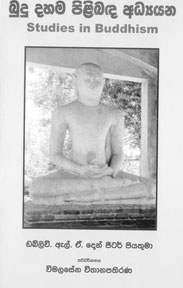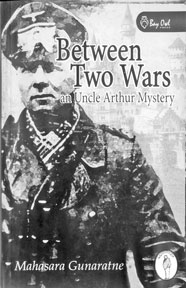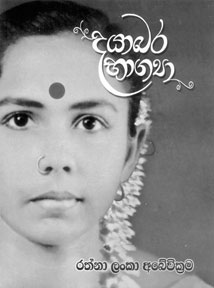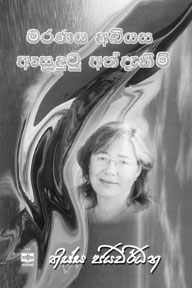|

Aid to study comparative religion
Reviewed by W. T. A. Leslie Fernando
 Budu
Dahama Pilibanda Adyana Budu
Dahama Pilibanda Adyana
Sinhala Translation of Studies in Buddhism by Fr. W. L. A. Don
Peter
Translator: Wimalasena Withanapathirana
Publishers: S. Godage and Bros.
This work is the Sinhala translation of ‘Studies, in Buddhism by Fr.
W. L. A. Don Peter published in 1997. The translator is Wimalasena
Withanapathirana who earliertranslated into Sinhala world-class books
like ‘Mind Unshaken’ by John Walter, ‘Power’ by Bertand Russell, ‘The
Prophet’ ‘by Kaleel Gibran’, On Liberty’ by John Stuart Mill, Marital
Breakdown, by Jack Dominion and ‘Encounters with Buddhism’ and ‘Good
Questions and Good Answers’ by Ven. Sravasti Dhammika Thera of
Australia.
It is significant that ‘Studies in Buddhism’ is written by Fr. W. L.
A. Don Peter the well-known Catholic priest, the great scholar, writer
and patriot who appreciates Buddhist doctrine, Buddhist way of life and
Buddhist culture. ‘Studies in Buddhism’ is a compendium of some articles
written now and then to journals by the late Fr. W. L. A. Don Peter.
In some of the articles, Fr. W. L. A. Don Peter admires Buddhist
teaching and way of life. In some others, he makes a comparative study
of Buddhist and Catholic institutions. In others he draws inspiration
from Buddhist culture and civilisation. Wimalasena Withanapathirana has
done a great service to Sinhala readers by translating this outstanding
work into Sinhala.
In the essay on the ‘Dhammapada’ Fr. Don Peter explains that
Dhammapada contains in the form of pithy maxims and the book as it were
the finest flowers of Buddhist teachings. He commends that a large
number of verses in it contains moral maxims of wise sayings which are
aptly expressed and illuminated.
They could be accepted by anyone whatsoever one’s religion may be and
even if one has no religion.
Fr. W. L. A. Don Peter in the chapter ‘The Middle Way of Buddhist
Ascetism’ expresses that the adherence to ascetism in a wisely mitigated
form has led to the growth of intellectual and educational activity
among the Sangha and how the monasteries became the centres of
educational and literary activities. Such would not have been the case
if Buddhist ascetism would have been so severe as in the case of Jains
and Ajivakas.
In the chapter ‘Celibacy in Buddhism’ Fr. Don Peter appreciates that
in Sri Lanka and in other countries where Theravada tradition is
followed, celibacy practised in early Buddhism is strictly adhered to as
the life of homelessness enables to Bhikkhus to give himself fully for
attainment of Nibbana.
Fr. Don Peter highlights that the Bhikkhu who accepts celibacy does
so to devote himself to spiritual culture undisturbed by the obligations
of married life. The Bhikkhu goes on to carry the tasks as he had to be
a teacher by word and example, a missionary and a guide, friend and
philosopher to people. He stresses that this is a reason given by the
Vatican Council II (1962-65) for the celibacy of Catholic priests - to
dedicate themselves in an undivided way the task assigned to them.
In the article ‘The Yellow Robe’ Fr. Don Peter observes when one
becomes a Bhikkhu he puts on the yellow robe which he thereafter wears
always. He will not part with it as long as he remains a Bhikkhu. Even
when he is travelling in the West, he always has the robes on. He does
not appear in public or even in the lodging without beingproperly robed.
He does not wear other kinds of dress or secular clothes.
Fr. Don Peter deals with the flimsy excuses and half truths of those
Catholic priests who jettison or modify the religious garb. Fr. Don
Peter contends that the religious garb protects the priest as it is a
constant reminder to himself and others - the high calling of
priesthood.
In essays such as ‘Reflections on a Buddhist Statue’ and ‘Lankan
Sculpture Buddhist and Christian’ Fr. Don Peter reminds us that though
Buddhism brought to Sri Lanka a sculpture from India seen at its best in
Buddhist shrines of Sanchi, Bharat and Amarvati, the Sri Lankan
sculpture developed on its own lines which have been hailed as a
masterpiece. He finds that Christ and Madonna paintings and sculpture in
Sri Lanka are general reproductions of European models.
In the article ‘The Buddha and St. Francis’, Fr. Don Peter analyses
that in spite of great differences in the doctrine in Buddhism and
Christianity, there is a close affinity on the other worldly aspects
that animated Buddha and St. Francis. In the teachings of Buddha a great
prominence is given to Meththa which is loving kindness to all living
beings. This corresponds to remarkable love for all living creatures by
St. Francis, observes Fr.Don Peter.
In the article ‘Monastic Movements in Buddhism and Christianity’ and
‘The Code of Law in Buddhist and Benedictine Monasticism’ Fr. Don Peter
makes a comparative study of Buddhistic monasticism and that of
Catholics specially of the Benedictine order. He concludes that though
monastic life at times bear resemblance and at times different from each
other, are a preparation for after life according to the teachings of
each religion.
In the last chapter ‘Buddhist and Christian Dialogue among Religions’
Fr. Don Peter draws attention to the fact how such an exercise would be
beneficial to both the religions. Fr. Don Peter affirms the fact that
the spirit of secularisation is affecting the Catholic Church
particularly in the West. Laxity of morals specially relating to sex,
move to rid of priestly celibacy and baneful influence of materialism
have adversely affected the Church. Fr. Don Peter suggests that the
Christian religion could find an all in the Buddhist religion drawn as
they are from the East where the spirit of religion prevails and
spiritual values are esteemed.
Fr. Don Peter states the aim of dialogue should not be to convert the
Buddhists to Christianity or vice versa but for the benefit of the cause
of religion. His approach is different from those who want to adulterate
Christianity to come to terms with Buddhism in the name of dialogue
which might lead to the destruction of both Christianity and Buddhism.
It is not an easy task to translate an indepth study of Buddhism by
comparing it with Christian aspects. Wimalasena Withanapathirana has
risen to occasion magnificently and has fulfilled his task. He has
translated the book in simple language and right royally performed his
task to make the translation apprehended by all. The book is neatly
printed in the glossy paper and it carries the same picture in the cover
found in the ‘Studies in Buddhism’. The book is moderately priced at Rs.
300. It should find a place in all libraries.
The evolution of Pirith
Reviewed by W.S. Karunathilaka
One of the dominant concepts in the conceptual framework that has a
bearing on religious practices of the Sri Lankan Buddhists is the notion
of Kamma, the ‘religio-ethical action’.
All practising Buddhists firmly believe in this, which alone is
considered by them as the conditioning factor of ‘rebirth’, yet another
profound and rather inscrutable notion in the conceptual framework,
Kamma/Karma as revealed by the current Buddhist practice can be broadly
classified under three rubrics - Punyakarma acts of merit that are done
with the ultimate aim of attaining - Nibbana - final emancipation ii-
Caritra Karma acts conditioned by social customs that are performed in a
Buddhist environment and iii- Shanthikarma benedictory action that are
done mainly to invoke blessings on an individual, a family, a society or
a country.
 Of
the many Shanthikarmas that Buddhists participate in, Pirith chanting is
generally accepted as the most significant. the chanting of Pirith by
Sri Lankan bhikkus invoking blessings on the three American
astronauts-Neil Armstrong, Mike Collins and Buzz Aldrin for their safety
and success of their space voyage that they launched on July 16, 1969 is
a classic example. Of
the many Shanthikarmas that Buddhists participate in, Pirith chanting is
generally accepted as the most significant. the chanting of Pirith by
Sri Lankan bhikkus invoking blessings on the three American
astronauts-Neil Armstrong, Mike Collins and Buzz Aldrin for their safety
and success of their space voyage that they launched on July 16, 1969 is
a classic example.
The work under review is on Pirith (chanting) which is the most
important benedictory action esteemed by Buddhists.
The main objective of the author in this book is to present a clear
and critical discussion on the evolution of the Pirith text and the
related ritual of Pirith chanting. As the author himself mentioned in
the preface the present work is his dissertation for PHD submitted to
the Post Graduate Institute of Pali and Buddhist Studies of the
University of Kelaniya in 2000.
As a brilliant researcher, he has diligently collated his findings
and incorporated them in his thesis. The book comprises 10 chapters,
introduction, the term Pirith and Pirith text, Discourse analyses 1,2,3,
Origin of the Buddhist benefactory ritual, Gradual evolution of the
notion of The Triple Gem and the rites connected with the Pirith
chanting ceremony, Development of later beliefs and indiginisation,
Development of the method of Pirith chanting with special emphasis on
orthoepy and the Correct rhythmic enunciation and conclusion.
As evident from the contents of this book the author has meticulously
collected all the relevant information consulting the primary and
secondary source material and with critical acumen he has made a
penetrating and almost exhaustive study of the cherished theme. The
hallmark of this work is its objectivity in that the author has gone
beyond popular beliefs and religious leanings showing rigorous academic
restraint. It meets the two main requirements of a scholarly treatise
viz. observational adequacy and explanatory adequacy.
The value of this work is enhanced by the Prof. Oliver Abeynayake’s
evaluative essay where he has highlighted almost all the new findings
found here and the long introduction by Prof. Asanga Tilakaratne
covering a vast area pertinens to the topic of the treatise.
It is written in lucid style in Sinhala and is readable. The book can
be rightly called the most authoritative work on the subject so far
written.
An English translation of this will be most welcome. The author Dr.
Gamunu Siri Gamage must be commended for presenting to the Sinhala
reading public a scholarly treatise of such magnitude which is of
lasting value.
Fiction set in colonial Ceylon
Reviewed by Padma Edirisinghe
One naturally expects the author of “Between two wars” to be somebody
connected to the battlefield warring in tough boots. But Mahasara
Guneratne, the author is a seasoned Medical Professor of Colombo, Sri
Lanka.
The back blurb describes him further as a Senior Gommonwealth Fellow
and Academic Historian. What further qualifies to put out a book of this
nature is that he has been born in 1934 and “experienced life during the
latter part of Colonial Ceylon”. Of course the First world War had been
fought and finished by the time he was born but the antecedents of his
plot go back even to that phase of world history making the book more
intensive.How did little Lanka, then an appendage of the British Empire
get tagged on to this landscape providing the Professor a tantalising
tale of a youth begotten out of love bonds alone who finally gets thrown
on our soil? Here is an exciting background that could provide fodder
for a highly dramatic film. The initial setting is the German Club of
Colombo. Writes the author,
 “The
German Club was situated in Cinnamon Gardens, facing the Colombo Museum
- At the beginning of the Century the German residents experienced
memorable days in Colombo far away from their motherland. Some even
decided to settle down here, opening reputable business houses”. The
wars changed all that but as it lasted high drama had been staged in or
around it.It is a complicated plot that the author unravels in a racy
style, the English language used rushing forth with a tremendous vigour
(no tepid Sri Lankan English much advertised these days). There is a
cavalcade of myriad characters rushing in and out of the story including
the youth Frank himself of simple unassuming ways (actually the
unfortunate main player in the tale). “The
German Club was situated in Cinnamon Gardens, facing the Colombo Museum
- At the beginning of the Century the German residents experienced
memorable days in Colombo far away from their motherland. Some even
decided to settle down here, opening reputable business houses”. The
wars changed all that but as it lasted high drama had been staged in or
around it.It is a complicated plot that the author unravels in a racy
style, the English language used rushing forth with a tremendous vigour
(no tepid Sri Lankan English much advertised these days). There is a
cavalcade of myriad characters rushing in and out of the story including
the youth Frank himself of simple unassuming ways (actually the
unfortunate main player in the tale).
Arthur, the recreational detective who really is the raconteur,
Esmeralda, the dame who runs the orphanage, Sister Hildegarde and the
German beauty Ingrid.The story takes us from colonial Ceylon to a
strange feudal set up in Germany where class distinctions and social
prejudices seem to dominate the country to a surprising degree so that
an innocent child is got rid of save faces. It takes one to a narrative
“crafted with just the right dose of suspense, adventure and mystery”.
And throughout the crowding events, the atmosphere of war in the
background is cleverly maintained. Here is chapter 18 titled “1939 - War
declared”.
“In September of 1939 Britain declared war. Ceylon under the British
was aligned to their cause... Expatriates began leaving including Sister
Hildegarde and the nuns.
The German Club was closed. In 1941 a new turn of events took place
when the Japanese entered the war. The situation escalated with rapid
conquests by the Japs followed by an air raid over Colombo. There was an
exodus from the city... The Pacific was shut off, no shipping, no
letters. It was useless making attempts to contact anyone in Germany or
in England”.
All that is part of the story that could be authentic or spawned out
of a rich imagination of the writer. But there is another dramatic bit
of news. Here is a writer who has not got the recognition he deserves.
It is not too late to make amends.
He is still young at 76 or 77, and still a busy medical practitioner
while wielding his pen too reviving long lost memories and crafting
wonderful stories out of genuine backgrounds. (The author has asserted
elsewhere that the book is a work of fiction set in colonial Ceylon and
borders upon historical sequences that fit into the period concerned).
New on the shelf
Sasala Diyavara

T. Wasantha Mendis’s maiden anthology of Sinhala poetry Sasala
Diyavara was launched at the Cultural Centre at Girandurukotte recently.
The poems written in the free verse style express his vision on the
reality of life.
Dayabara Bhagya

Author: Rathna Lanka Abeywickrama
Printed by Tharanji Printers, Maharagama.
Maranaya Abiyasa Esa dutu Athdekeem

Author: Tissa Jayawardena.
A Sadeepa Publication.
|

